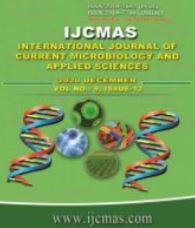


 National Academy of Agricultural Sciences (NAAS)
National Academy of Agricultural Sciences (NAAS)

|
PRINT ISSN : 2319-7692
Online ISSN : 2319-7706 Issues : 12 per year Publisher : Excellent Publishers Email : editorijcmas@gmail.com / submit@ijcmas.com Editor-in-chief: Dr.M.Prakash Index Copernicus ICV 2018: 95.39 NAAS RATING 2020: 5.38 |
Hanuman Langurs are widely distributed nonhuman primates in India. There are no reports on their status and their distribution in Jhalawar district, Rajasthan, India. Hence, the study was conducted to know their present status and distribution in the region. During the study it was observed that there is a considerable population of the Hanuman Langur with 36 troops constitute 386 langurs of which 82 adult males, 203 adult females, 82 juveniles, and 19 infants. it is observed that the Hanuman langur were recorded at 8 different sites with the mean population of 48.25 (F= 2.65, P= 0.78, P>0.05, Non Significant ), Anova result reveals that there was no statistically significant difference in social compositions present among different study sites. Troop size of Hanuman langur was ranges between 03 individuals to 20 with a mean troop size of 10.17 individuals ( t – Test:=0.05, P=0.132, P< , significant) t-Test result reveals that, there was statistically significant difference in Individuals in Troop and population size. Among the population, Adult female was found to be highest 52.5%, followed by 21.2% was same for Adult male and Juveniles and 4.9% was Infants. In total population size of Hunuman langur age- sex ratio, the estimated adult male and adult female was 82: 203. Again, the Adult Female: Juveniles ratio was 203:82, that of Adult Male: Juveniles ratio was 1:1 and Juveniles: Infants ratio was 82:19.
 |
 |
 |
 |
 |